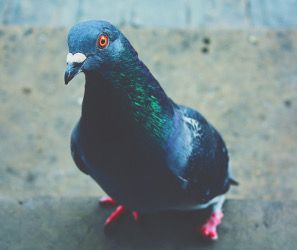Getting pooped on by pigeons
I don’t care how much you like animals, you gotta admit that getting showered by pigeon feces is one of the shittiest (pun intended) experiences out there. Especially if they hit your head, which is very likely given the surface area anyway. Or, in my case, when a bunch of these feathered demons conveniently decide to simultaneously empty their bowels when I’m right underneath them. I don’t harm animals, but oh man, did that ridiculously voluminous poopshower awaken a murderous primal rage in me.

You can see the evil in its eyes, can’t you?
As I was cooling down from this rather unfortunate experience, I started thinking about what happened to me and why. I suddenly remembered that feeding pigeons is increasingly problematic in densely-populated cities, and that in some places it’s even illegal to feed them. Since this is probably done to prevent health hazards, I’m guessing avoiding pigeon poop has to be the relevant parameter here. After all, feces are breeding places for all kinds of bacteria, right?

The less people do this, the less dirty bird poop on unsuspecting heads
So here’s the million-dollar question: What’s the probability, P, of getting pooped on by pigeons when you’re in a city? Let’s look at the most important parameters that are relevant:
- The city’s population density, D: The bigger D is, the higher the chance you’ll get pooped on. For big cities, D ~ 5,000 people/km2.
- The city’s total area, A: For big cities, A ~ 500 km2.
- The typical area occupied by a person (as viewed from above), a: My rough estimate is that a ~ 0.5 m2.
- The average pigeon feeding rate per capita, r. This is essentially the free parameter we’ll be playing with to see why people care about its value.
- How much food a typical pigeon needs to survive, f: According to this site, f ~ 10 g/day.
- The pigeon pooping rate, p: According to a self-professed pigeon owner on this forum, p ~ 100 poops/day.
- The pigeon population density, d: This is obviously the parameter we’re interested in, particularly its dependence on r.

Math is a good way of diffusing anger caused by certain devious avian poopsters
I know the math seems intractable, but bear with me. Let’s first find how d depends on r, and possibly other parameters. This is rather simple when we consider the following example: If all D people within 1 km2 fed pigeons at a per capita rate r = f, there’d be a population of d = D pigeons in the same area. Adjusting for a variable feeding rate, we find that
Equation (1) makes sense, since—as you can check for yourself by plugging in some relevant numbers—it makes a series of very reasonable predictions: (a) for a given feeding rate, the bigger the city’s population, the bigger the pigeon population, (b) for a given city, the more people feed pigeons, the bigger the pigeon population. But there’s an even better reality check we can do.
From personal experience, I’d say that, in big cities, there’s about 1 pigeon per 50 meters or so; that is, d ~ 100 pigeons/km2. Since we know f ~ 10 g/day, equation (1) can be rearranged to give r ~ 0.1 g/day. Given that a slice of bread weighs about 50 g, that means the average pigeon feeding rate is about about a slice of bread per year, per person. That’s a very reasonable number indeed.

This is how I feel when the math makes sense (kinda sorry, I know)
OK, so how do we calculate P? This obviously depends on the time t you spend walking around; to make our lives easier, let’s assume t ~ 1 hour for every day you spend in a city. Assuming pigeon bowels are equally likely to be emptied anywhere in a city, P can be estimated as the probability that at least a single dropping will land on your head. Or, in math language,
where e = 2.71828... is Euler’s constant. (For the math nerds out there, the last two approximations in (2) are the limit-definition and Taylor-series expansion of the exponential function, respectively.) We’re basically done: We just need to flesh out the implications of (2) by looking at a few examples.

I know, I know; just hold on a little longer
To make our lives easier, I’ll assume that r/f = 0.01, and calculate P from (2) for 1 year of 1-hour-long walks per day, for a few cities with different sizes and population densities. The results, along with the estimated yearly rate at which pigeon droppings fall on people’s heads, W, are listed in the table below.
| City | A (km2) | D (people/km2) | P (%) | W (kg/year) |
| Athens | 412 | 7,500 | 6 | 50 |
| Amsterdam | 219 | 5,135 | 4 | 10 |
| Heraklion | 245 | 920 | 1 | 1 |
| Wormer | 16 | 821 | 1 | 0.04 |
The conclusion from the data is unequivocal: In big cities, people accumulate a lot of pigeon poop on their heads every year. Since scaling up from small to big cities gives rise to health issues caused by pigeon poop, we need to reduce pigeon populations in our cities. Can we do that in a non-violent way? Based on the analysis so far, the answer is yes: Only feed pigeons if it’s your first time, or if you can’t remember the last time you did so. They can take care of themselves.
